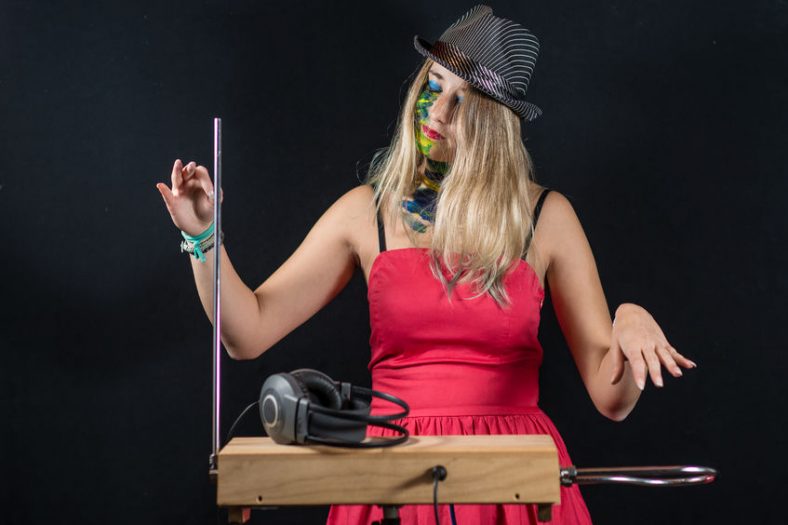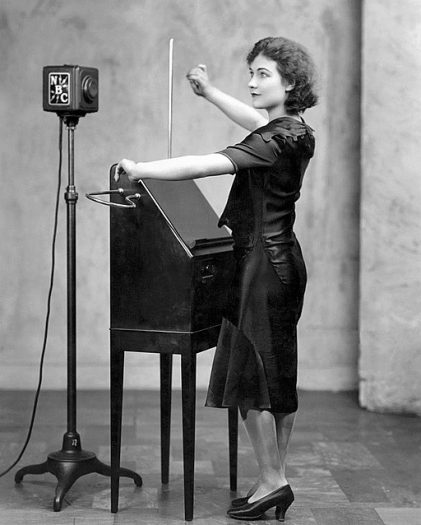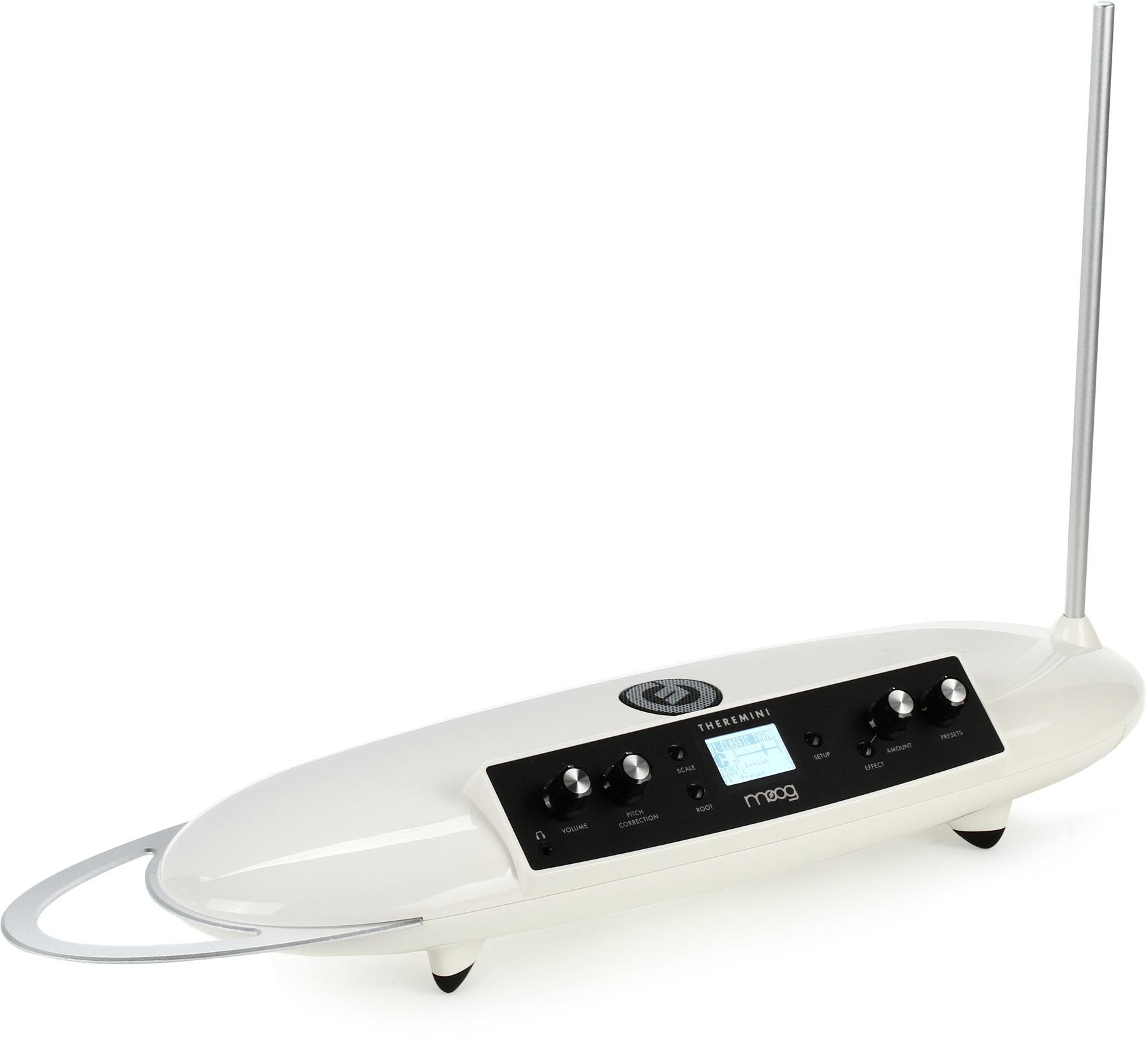The Theremin – The Musical Instrument You Play Without Touching

The theremin is an electronic instrument played without the player touching it. It has a unique timbre, and it takes much practice to play well. It is also referred to as an etherphone, a thereminophone, or a thereminvox.
Nowadays, more and more people have gotten to know this peculiar instrument, once largely unfamiliar to the general public.
You may know it for its very unique timbre. You may have watched The Big Bang Theory character Sheldon Cooper perform a weird version of Nobody Knows The Trouble I’ve Seen on it.
With the popularity of online platforms such as YouTube, where niches manage to thrive and sometimes become mainstream, the theremin is experiencing an unexpected wave of notoriety.
However, its functionality is still a big mystery to many. How did it originate? How can I buy one? How is it played? In what contexts is it used?
Before we get into answering those questions, check out this great video below that demonstrates it being played by a very skilled player:
Contents
- The Theremin – At a Glance
- What Is a Theremin?
- Interesting Facts About Theremin
- How Much Does a Theremin Cost?
- Recommended Theremins
- 1. Moog Etherwave Standard Theremin
- 2. Moog Theremini
- How Do You Play the Theremin?
- Is a Theremin Hard to Play?
- How Does the Theremin Work?
- Does a Theremin Need an Amp?
- What does a Theremin Sound Like?
- The History Of Theremin
- Summary
The Theremin – At a Glance
- The theremin is a unique electronic instrument played without physical contact, known for its eerie timbre.
- Pop culture references, like Sheldon Cooper’s performance on “The Big Bang Theory,” have increased its visibility.
- The instrument’s history intertwines with remarkable players and iconic pop culture moments.
- Virtuoso Clara Rockmore elevated the theremin’s status with her mesmerizing performances.
- The Beach Boys, Led Zeppelin, and The Rolling Stones incorporated the theremin into their music, adding to its allure.
- The theremin’s eerie sound found its way into sci-fi films like “Forbidden Planet.”
- The mysterious disappearance of inventor Léon Theremin adds intrigue to the instrument’s history.
- Robert Moog drew inspiration from the theremin for his synthesizers.
- Contemporary thereminists like Carolina Eyck and Pamelia Kurstin continue to push the instrument’s boundaries.
- The theremin’s enduring appeal lies in its versatility and expressive capabilities.
- Learning to play the theremin is challenging but rewarding, with a unique interface controlled by hand movements.
- The instrument’s timbre can range from spooky to soft, making it suitable for various musical contexts.
- The theremin has a rich history and is experiencing a 21st-century revival.
- It can be purchased in the $250-500 price range, with used options available.
- The theremin’s unique interface and expressive potential make it an intriguing choice for musicians.
What Is a Theremin?
A theremin is an electronic musical instrument known for its unique and eerie sound. It is played without physical contact, as the musician’s hands manipulate the electromagnetic fields around two antennas.
One antenna controls pitch, and the other controls volume, allowing the player to create music by moving their hands in proximity to these antennas. The theremin’s sound is often described as spooky and otherworldly, making it a distinctive and intriguing instrument.
Interesting Facts About Theremin
The theremin, often dubbed the “spookiest” of instruments, boasts a captivating history that intertwines with remarkable players and iconic pop culture moments. Prepare to be intrigued as we unveil ten electrifying facts about the theremin, shedding light on its influential role and unforgettable performances:
- Clara Rockmore: The Virtuoso Marvel
Clara Rockmore, a theremin virtuoso, wowed audiences in the early 20th century with her mesmerizing performances. Her unmatched precision and grace elevated the theremin to new heights, making her an enduring legend in the world of electronic music.
- The Beach Boys’ Cosmic Touch
The theremin made a cosmic splash in pop culture when The Beach Boys incorporated it into their 1966 hit “Good Vibrations.” Its eerie sound added an otherworldly dimension to the song, solidifying the theremin’s status as a pop culture icon.
- Led Zeppelin’s Magical Spell
Jimmy Page, the iconic guitarist of Led Zeppelin, used a theremin on stage to create haunting and mystical effects during the band’s legendary live performances. It’s no wonder their concerts left audiences spellbound.
- Rolling Stones’ Experimental Edge
Brian Jones of The Rolling Stones harnessed the theremin’s ethereal tones on their 1967 album “Between the Buttons.” The instrument’s unique sound injected an experimental edge into the band’s music.
- Sci-Fi Soundscapes: Forbidden Planet
The theremin’s eerie allure found its way into the science fiction film “Forbidden Planet” (1956), creating a soundscape that perfectly matched the film’s interstellar adventures.
- The Day the Earth Stood Still’s Cosmic Tones
In “The Day the Earth Stood Still” (1951), the theremin played a central role in crafting the movie’s mysterious and futuristic soundtrack, setting the stage for an unforgettable cinematic experience.
- The Mysterious Disappearance of Léon Theremin
Intrigue surrounds the inventor himself, Léon Theremin. He mysteriously disappeared during the 1930s, sparking rumors of Siberian exile due to exporting his Russian invention. His enigmatic vanishing only adds to the lore of the theremin.
- Robert Moog’s Journey
Robert Moog, the genius behind the Moog synthesizer, was deeply inspired by the theremin. He built his first theremin as a teenager, eventually using his knowledge to revolutionize the world of synthesizers.
- 21st Century Revival
Today, thereminists like Carolina Eyck and Pamelia Kurstin continue pushing this unique instrument’s boundaries. They’ve developed innovative techniques and captivated audiences worldwide, proving that the theremin’s allure transcends time.
- A Musical Challenge Worth Embracing
No matter how strange or spooky it may seem, the theremin’s enduring appeal lies in its versatility and the challenges it presents to musicians. As technology evolves, this captivating instrument is poised for an exciting future in music.
The theremin’s journey through history, guided by these masterful players and unforgettable pop culture moments, cements its status as a truly electrifying musical enigma.
How Much Does a Theremin Cost?
You can buy relatively cheap Theremins, but if you want to get a new and good quality one, you’re looking at least between the $250-500 price range.
If you have a lower budget, you should check if there are any used theremins for sale. We would recommend that you get a higher-end used theremin, rather than getting a low-quality budget one.
Recommended Theremins
1. Moog Etherwave Standard Theremin
2. Moog Theremini
How Do You Play the Theremin?
Where’s the fretboard?! The first thing you’ll notice in a theremin is the absence of anything slightly resembling a keyboard or a fretboard. There are no keys nor frets, just two metal antennas, which make this instrument more similar to a radio or a modem than a musical instrument.
However, you’ll need to get close to the antennas to hear the magic happen.
The concept behind the instrument is fascinating: you play the theremin with your body, particularly your hands and arms.
Your fingers, wrists, and palms become the frets and keys to emit a specific pitch.
However, the sound emission happens without physical contact between the player and the instrument.
Is a Theremin Hard to Play?

This instrument is extremely tough to learn and master, but you must start somewhere. It might take years of practice to be ready to perform for an audience.
As with any instrument, it isn’t easy to play at the start, but you can become skilled at playing it. Even slight changes in your hand position can make quite a difference to the pitch or loudness, but you soon start to get the feel of playing it.
How Does the Theremin Work?
The theremin operates by sensing hand movements via antennas, converting them into electric signals, and then amplifying and transmitting them through a speaker. One antenna controls pitch (typically on the right), and the other manages amplitude (usually on the left).
Closer proximity to the first antenna results in higher pitch, while the second antenna controls volume; closer means louder. This unique interface, where hand movements finely tune pitch and volume, offers musicians an exceptionally expressive tool. Many musicians favor the real theremin over synthesized versions for their unparalleled expressive capabilities.
Does a Theremin Need an Amp?
Some Theremins contain built-in speakers; others do not. Built-in speakers are great for practicing, but having an amp when playing it with other musicians or for live performances is necessary.
Theremins often have 1/4″ output jacks (the size of guitar and instrument cables); cables of these sizes can generally be connected directly to amps and mixers.
What does a Theremin Sound Like?
The theremin has a very unique sound, often described as eerie, spooky, ethereal, or alien. Due to this particular timbre, it is sometimes featured as part of the soundtrack to sci-fi or horror movies.
However, high-end theremins have the option of switching among different timbres. A theremin can indeed sound spooky and ghostly, but it can also be as soft as a cello.
The theremin is monophonic, so it is perfect for an ensemble with more traditional instruments, such as the piano, the guitar, or even whole orchestras.
When playing solo, thereminists might enrich their performances through the use of effects, such as delay, reverb, and harmonizer, creating an interesting palette of expressive options.
The History Of Theremin

The theremin, one of the earliest electronic instruments, was invented by Russian physicist Léon Theremin and patented in the United States in 1928. Its popularity grew in the U.S., notably thanks to violinist Clara Rockmore, while Léon Theremin mysteriously disappeared during the 1930s.
In the 1950s, the theremin waned in popularity as more versatile electronic instruments emerged. However, enthusiasts, including Robert Moog, who later developed synthesizers, continued to appreciate its unique charm and was inspired by it for his own inventions.
Today, the theremin is experiencing a revival, with musicians like Carolina Eyck and Pamelia Kurstin enhancing both the instrument and playing techniques.
It has also been used in rock music by many bands, such as he Beach Boys and Led Zeppelin. The theremin’s enduring appeal lies in its versatility, fitting various music styles and providing an exciting challenge for musicians. Its future holds promise as technology shapes and enriches this remarkable instrument.
Summary
The theremin is a unique monophonic instrument with so much versatility that it can be perfect for an ensemble or by itself.
When playing solo, thereminists might enrich their performances through the use of effects, such as delay, reverb, and harmonizer, creating an interesting palette of expressive options.
Also, some features of this instrument might appear daunting at first sight, but they are stimulating challenges that encourage performers and composers to search for new sounds and techniques.
Another key feature of this instrument is its portability, which makes it also interesting for buskers. In conclusion, the theremin is a versatile instrument that can be used in different styles of music and musical contexts.







